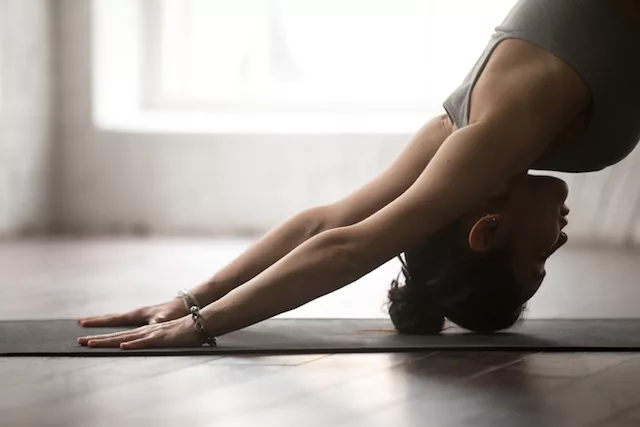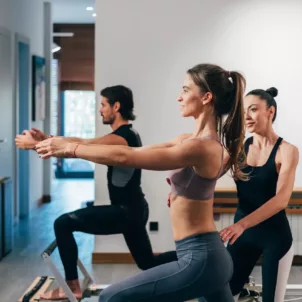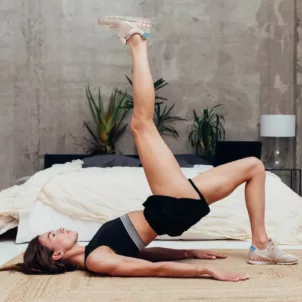If you want to create an exercise regimen that feels a little more intuitive and in sync with your body’s needs, cycle-syncing workouts might be for you. During the menstrual cycle, estrogen and progesterone — two hormones that play key roles in reproduction — rise and fall depending on the phases of menstrual cycle. As a result, energy levels can shift a lot during menstruation, the follicular phase, ovulation, and the luteal phase, which can impact the way you workout.
One of the key benefits of cycle-syncing workouts is that it’s a way to match your energy levels and exercise choices. But, it’s also a way to feel more aligned with your body in general. “Playing with cycle syncing can also encourage a variety of movements across a cycle, allowing you to both challenge your body and let it recover to come back stronger,” says Angie Marie, a fertility awareness educator, doula, and author of The Cycle Syncing Handbook. “It also teaches you to give yourself grace when you don’t perform the same way every day,” she adds.
Up ahead, we dive into the phases of menstrual cycle, how they impact your energy, and the benefits of cycle-syncing workouts. We also learn more about the best exercises for the four stages of menstrual cycle, plus some tips on how to start cycle syncing.

Phases of Menstrual Cycle and How They Impact Your Energy
There’s a lot going on behind the scenes of your menstrual cycle, especially regarding hormones. Because of this, the menstrual cycle can significantly impact energy levels (yes, this means there’s a reason why you might feel more motivated to do that HIIT workout one week but not the other). By learning more about the phases of menstrual cycle and how your energy changes during your menstrual, follicular, ovulation, and luteal phase, you can maximize your workout routines and select exercises that feel like more of a match for your body at different points throughout the month.
Menstrual
“The most visually obvious phase of the cycle is the menstrual phase, when you’re on your period,” says Marie. If the egg that is released during ovulation is not fertilized and pregnancy does not occur, the body experiences a drop in progesterone, which signals the uterus to shed its lining. “For many menstruators, the first date or two of a period can feel tiring due to the sharp decline in estrogen and progesterone levels as well as a possible loss of nutrients,” Marie notes.
Follicular
The follicular phase is the time between your period and leading up to ovulation when your ovarian follicles grow, says Marie. Estrogen rises during the follicular phase and then drops after ovulation. “After your period ends, you might start to feel gradually more energetic, with energy peaking around ovulation,” Marie notes.
Ovulation
Ovulation is the phase of your cycle when the egg releases from an ovary and, according to Marie, the main event of the menstrual cycle. “Without ovulation beforehand, you wouldn’t get a true period,” she explains. Considering evolutionary biology, the ovulation phase is when Mother Nature wants you to be out and about, looking for a mate. Because of this, Marie says that energy levels are increased during this phase. “You might feel more motivated, confident, and enthusiastic about workouts or life in general,” she explains.
Luteal
“The time after ovulation and leading up to your next period is called the luteal phase,” says Marie. During this time, the corpus luteum organ (which, according to the Cleveland Clinic, is a “temporary collection of cells that forms on your ovary each menstrual cycle” and is responsible for preparing the uterus for pregnancy) forms and produces progesterone. From an energy standpoint, your metabolism and hormone levels cyclically change during the luteal phase, so it’s common to experience a decline in energy, says Marie. “Caloric needs increase in the luteal phase, so menstruators who don’t fuel enough may feel even more tired than usual,” she adds.
Cycle Syncing Workouts
If you want to work within the natural ebb and flow of energy levels, syncing your workouts to the phases of your menstrual cycle can help. Here’s what you need to know about how to cycle sync workouts.
Menstrual
According to Marie, symptom management is key in the menstrual phase. “Biologically, it is still possible for menstruators to hit their personal bests while on their period,” she explains. “There is no biological reason to rest, unless your symptoms are begging you to,” she adds. With this in mind, it’s common for menstruating individuals to experience uncomfortable and sometimes even painful cramps or other symptoms that might get in the way of their usual workouts. Additionally, the drop in energy levels during the first couple of days of menstruation can also make it harder to stay motivated through tough workouts.
Since energy is low, Kate Baldasare, a NASM-certified personal trainer, pre and postnatal certified trainer, and a corrective exercise specialist, says to listen to your body and consider walking, yoga, or stretching during this phase. “Movement typically does help with cramping and can help you to feel restored,” she adds. If you don’t feel depleted while on your period, Marie says you can exercise as usual, but it’s worth considering the mental effects of this phase. “Many menstruators feel more introspective, inward-focused, and quiet during this time,” she explains. If this speaks to you, she recommends using this phase as an opportunity for incorporating mental stillness in your workout regimen, like going on a long, slow run in nature, adding breathwork at the end of your workout, or even trying a walking meditation. Finding a place to exercise near water or another peaceful setting can also elevate this phase of your cycle.
Follicular
The follicular phase is one of the most high-energy periods in your cycle. And, as your estrogen starts to rise, Marie says your energy, motivation, and confidence increase along with it. “This could be a great time to try something new as it pertains to fitness, like that class you’ve had your eye on, a new sports club, dancing, or a new hiking loop,” she notes. According to Baldasare, this is the best time to add strength training and light cardio back into your routine, too.
Timing can also play a role when exercising during this phase. “Many menstruators feel happy timing their exercise for midday in their follicular phase, due to rising estrogen,” Marie notes.
Ovulation
“Thanks to a spike in testosterone, your exercise performance will ideally peak during ovulation, so now is the time for high-intensity interval training, heavier weight lifting, or a sweaty dance cardio workout,” says Baldasare. During this phase, some also experience peak competitiveness and a more “daredevil attitude,” says Marie, making it a great time to push for a personal record.
During the ovulation period, many are attracted to more social settings and groups of people, so Marie says to consider switching up your routine to run with a pack or sign up for a group fitness class if that isn’t already part of your routine. And, timing-wise, she recommends exercising in the morning “since your motivation is high and you have energy to burn.”
Luteal
As the body enters the luteal phase, you might notice a dip in energy — though it won’t be as low as during the menstrual phase. “Keep up your strength training if you can and start to back low-impact exercises like Pilates or yoga back in to prepare for the menstrual phase,” Baldasare recommends. The luteal phase is also an ideal time for tending to anything you typically neglect, says Marie. This can include focusing on injury recovery, deep stretches, or those smaller muscle groups you forget about. When in the luteal phase, you might also experience a pull to turn back inward, so it’s common to exercise solo vs. in a group setting.
This phase is unique in that you start the phase with energy levels similar to the ovulation phase, but as the days go on, Marie says you might feel lower energy levels and can even start to experience PMS symptoms. Because of this, she says it’s best to listen to your body about when to workout and when to rest—you might start the phase with morning exercise and end it with an easeful evening sweat sesh.
Tips for Cycle Syncing Workouts
To improve your cycle syncing experience and support your body’s energy levels throughout the month, here are some tips for cycle syncing workouts from Marie and Baldasare.

Identify the Phases of Your Cycle
To start cycle-syncing workouts, you first need to identify your phases. “You can start to count your days to reach the four phases based on the first start date of your period and even try an at-home ovulation kit to see if you are on track,” says Baldasare. Once you identify the average range of your cycle, Baldasare recommends starting a cycle-syncing workout regimen during the menstrual phase. “You can start there with aligning your workouts throughout the next month and start the routine again when your period starts,” she notes.
Listen To Your Body
Intuition plays a role in the menstrual cycle in general. So, to honor that, it’s important to listen to your body (whether you cycle sync workouts or not). While Baldasare says there is nothing unsafe or dangerous about any type of workout regarding the phases of menstrual cycle, it’s still important to listen to your body and consider your physical and mental energy. “There’s no need to push yourself on a higher energy day if you feel like you need to rest,” she notes.
Fuel Your Body During Ovulation
During the ovulation phase, energy levels are heightened, and you might enjoy more intense workout sessions — but don’t forget to eat and refuel to support these workouts. “It’s easy to forget your needs when everything is so exciting,” Marie notes.
Eat Protein Post-Exercise During the Luteal Phase
The luteal phase is progesterone-dominate and, according to Marie, this hormone is catabolic by nature (meaning, it breaks down muscle). “That might mean that you need to prioritize getting in enough protein post-exercise quickly during the luteal phase,” she explains. The metabolism also increases during the luteal phase (which is why you feel hungrier before your period). Because of this, Marie says you need more calories in general during the luteal phase and recommends increasing calories, protein, and rest to feel optimal.
Supplement When Needed
If you experience menstrual cramping, Marie says to make sure you get enough magnesium, zinc, and HUM’s omega-3 fatty acids the week before your period. Consider supplementing as well as eating foods that are rich in these nutrients to support your body in its cycle as well as your exercise regimen. And, if menstrual headaches are also a concern, Marie says to incorporate foods that are rich in nitric oxide into your diet.
We suggest incorporating out SOS PMS Gummies to help with PMS symptoms!
While there isn’t anything dangerous about trying a HIIT class during your menstrual phase or slowing down for some gentle yoga during ovulation, cycle syncing can help you feel more in tune with your body’s energy levels and, as a result, can elevate your exercise experience. Doing so can also have a positive impact on your mood, and can even help alleviate some PMS symptoms, too.








